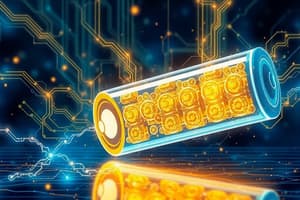Podcast
Questions and Answers
What causes the development of a potential difference across the barrier in a solution?
What causes the development of a potential difference across the barrier in a solution?
- The equal mobility of H^+^ and Cl^−^ ions
- The greater mobility of H^+^ ions compared to Cl^−^ ions (correct)
- The concentration of Cl^−^ ions being higher than H^+^ ions
- The negative charge of the H^+^ ions in the solution
What is the term for the steady state potential difference that exists when both H^+^ and Cl^−^ ions cross over at the same rate?
What is the term for the steady state potential difference that exists when both H^+^ and Cl^−^ ions cross over at the same rate?
- Osmotic potential
- Standard Electrode Potential
- Electrochemical potential
- Liquid Junction Potential (correct)
What is the purpose of using a salt bridge filled with ions of similar mobilities in an electrochemical cell?
What is the purpose of using a salt bridge filled with ions of similar mobilities in an electrochemical cell?
- To improve the efficiency of the cell (correct)
- To decrease the temperature of the system
- To promote the oxidation of metals
- To increase the concentration of H^+^ ions
Under what conditions does the Nernst Equation allow for calculations of electrochemical cell potential?
Under what conditions does the Nernst Equation allow for calculations of electrochemical cell potential?
In the context of electrochemical cells, what happens to the electrical energy when overcoming the liquid junction potential?
In the context of electrochemical cells, what happens to the electrical energy when overcoming the liquid junction potential?
What occurs at the cathode in an electrochemical cell?
What occurs at the cathode in an electrochemical cell?
Which statement accurately describes the oxidation process in this electrochemical system?
Which statement accurately describes the oxidation process in this electrochemical system?
What is the role of the salt bridge in an electrochemical cell?
What is the role of the salt bridge in an electrochemical cell?
Which metal is undergoing reduction in the reaction involving Cu and Zn?
Which metal is undergoing reduction in the reaction involving Cu and Zn?
What happens to the equilibrium when an electron is added to the Cu half-cell?
What happens to the equilibrium when an electron is added to the Cu half-cell?
What is the result when all Zn metal is oxidized in the electrochemical cell?
What is the result when all Zn metal is oxidized in the electrochemical cell?
How can the potential for non-standard half-cells be determined?
How can the potential for non-standard half-cells be determined?
In an electrochemical cell, the amount of oxidation at the anode is equal to what?
In an electrochemical cell, the amount of oxidation at the anode is equal to what?
What describes the state of equilibrium at the metal-electrolyte interface?
What describes the state of equilibrium at the metal-electrolyte interface?
Which equation relates the potentials of an electrochemical cell to temperature and concentration?
Which equation relates the potentials of an electrochemical cell to temperature and concentration?
What does the charge on the metal side of the interface depend on?
What does the charge on the metal side of the interface depend on?
Which of the following describes the nature of metals at the metal-electrolyte interface?
Which of the following describes the nature of metals at the metal-electrolyte interface?
What occurs when two species in different phases are in equilibrium?
What occurs when two species in different phases are in equilibrium?
What does the exchange current density indicate in electrochemical kinetics?
What does the exchange current density indicate in electrochemical kinetics?
What is the term for the Gibbs energy per mole of an uncharged species?
What is the term for the Gibbs energy per mole of an uncharged species?
Which type of voltammetry involves the potential being changed linearly with time?
Which type of voltammetry involves the potential being changed linearly with time?
What additional factor contributes to the change in energy when a charged species moves across an interface?
What additional factor contributes to the change in energy when a charged species moves across an interface?
What leads to a build-up of positive charges on the metal during equilibrium?
What leads to a build-up of positive charges on the metal during equilibrium?
What is one main function of Pourbaix diagrams in corrosion studies?
What is one main function of Pourbaix diagrams in corrosion studies?
What characteristic of batteries reflects their ability to store energy over time?
What characteristic of batteries reflects their ability to store energy over time?
What is represented by the symbol μ in the context of chemical potential?
What is represented by the symbol μ in the context of chemical potential?
Which statement about fuel cells is correct?
Which statement about fuel cells is correct?
Which of the following species would likely prefer to be in a metallic state?
Which of the following species would likely prefer to be in a metallic state?
The equation ∆G = μsolution − μsolid describes which type of change?
The equation ∆G = μsolution − μsolid describes which type of change?
What happens to the Fermi Level when a more positive potential is applied to the electrode?
What happens to the Fermi Level when a more positive potential is applied to the electrode?
What does the exchange current density represent in an electrochemical system?
What does the exchange current density represent in an electrochemical system?
When the electrode potential is decreased from +0.77 V to +0.5 V, which reaction is favored?
When the electrode potential is decreased from +0.77 V to +0.5 V, which reaction is favored?
At equilibrium, what is the condition of net current density?
At equilibrium, what is the condition of net current density?
What is the effect of making the electrode potential more negative?
What is the effect of making the electrode potential more negative?
In the context of electron transfer, what is the significance of the Nernst Equation?
In the context of electron transfer, what is the significance of the Nernst Equation?
What are the oxidation and reduction processes characterized by when considering electron movement?
What are the oxidation and reduction processes characterized by when considering electron movement?
What is the effect of reaching equilibrium between the Fermi Level and the energy levels of ions in solution?
What is the effect of reaching equilibrium between the Fermi Level and the energy levels of ions in solution?
What does it indicate when both E_cell is positive and ΔG is negative?
What does it indicate when both E_cell is positive and ΔG is negative?
In the Nernst equation, what is the significance of concentrations being in mol dm^-3?
In the Nernst equation, what is the significance of concentrations being in mol dm^-3?
When using the Nernst equation, which of the following assumptions is made about solids?
When using the Nernst equation, which of the following assumptions is made about solids?
What is the relationship between ΔS and E_cell when temperature changes?
What is the relationship between ΔS and E_cell when temperature changes?
In a cell composed of Cu|Cu^2+ and Ag^+|Ag, what happens to the copper ions during the reaction?
In a cell composed of Cu|Cu^2+ and Ag^+|Ag, what happens to the copper ions during the reaction?
Which condition does not affect the effective concentration used in the Nernst equation?
Which condition does not affect the effective concentration used in the Nernst equation?
Which parameter can be estimated by measuring how E_cell changes over a short temperature range?
Which parameter can be estimated by measuring how E_cell changes over a short temperature range?
What determines the spontaneity of a reaction based on E_cell and ΔG?
What determines the spontaneity of a reaction based on E_cell and ΔG?
Flashcards
Electrochemical Half-Cell
Electrochemical Half-Cell
A system consisting of a metal in contact with a solution containing its ions, where a dynamic equilibrium is reached between metal dissolution and deposition.
Electrochemical Equilibrium
Electrochemical Equilibrium
The state where the rate of metal cations moving into solution equals the rate of cations depositing back onto the metal. This results in a constant concentration of metal ions in the solution and a stable potential.
Electrochemical Potential
Electrochemical Potential
The difference in electrical potential between a metal electrode and its solution, reflecting the tendency of the metal to donate or accept electrons. It's a measure of the potential energy associated with an electrochemical reaction.
Metal-Electrolyte Interface
Metal-Electrolyte Interface
Signup and view all the flashcards
What happens when a metal is placed in a solution containing its ions?
What happens when a metal is placed in a solution containing its ions?
Signup and view all the flashcards
What is the significance of electrochemical equilibrium?
What is the significance of electrochemical equilibrium?
Signup and view all the flashcards
Interfacial Potential Difference
Interfacial Potential Difference
Signup and view all the flashcards
Chemical Potential
Chemical Potential
Signup and view all the flashcards
Equilibrium Conditions
Equilibrium Conditions
Signup and view all the flashcards
Noble Metals
Noble Metals
Signup and view all the flashcards
Charge Build-up
Charge Build-up
Signup and view all the flashcards
Gibbs Energy and Equilibrium
Gibbs Energy and Equilibrium
Signup and view all the flashcards
Faraday Constant
Faraday Constant
Signup and view all the flashcards
Electrochemical Cell
Electrochemical Cell
Signup and view all the flashcards
Reduction Reaction
Reduction Reaction
Signup and view all the flashcards
Oxidation Reaction
Oxidation Reaction
Signup and view all the flashcards
Cathode
Cathode
Signup and view all the flashcards
Anode
Anode
Signup and view all the flashcards
Half-Cell
Half-Cell
Signup and view all the flashcards
Salt Bridge
Salt Bridge
Signup and view all the flashcards
Nernst Equation
Nernst Equation
Signup and view all the flashcards
Liquid Junction Potential
Liquid Junction Potential
Signup and view all the flashcards
How does a Salt Bridge minimize Liquid Junction Potential?
How does a Salt Bridge minimize Liquid Junction Potential?
Signup and view all the flashcards
Why is it more intuitive to apply the Nernst Equation to individual half-cells?
Why is it more intuitive to apply the Nernst Equation to individual half-cells?
Signup and view all the flashcards
Standard Conditions
Standard Conditions
Signup and view all the flashcards
Spontaneous Reaction
Spontaneous Reaction
Signup and view all the flashcards
Non-spontaneous Reaction
Non-spontaneous Reaction
Signup and view all the flashcards
Cell Potential (Ecell)
Cell Potential (Ecell)
Signup and view all the flashcards
Gibbs Free Energy (ΔG)
Gibbs Free Energy (ΔG)
Signup and view all the flashcards
Standard Cell Potential (E°cell)
Standard Cell Potential (E°cell)
Signup and view all the flashcards
Equilibrium Potential
Equilibrium Potential
Signup and view all the flashcards
Exchange Current Density (io)
Exchange Current Density (io)
Signup and view all the flashcards
Overpotential (η)
Overpotential (η)
Signup and view all the flashcards
Effect of a More Positive Potential
Effect of a More Positive Potential
Signup and view all the flashcards
Effect of a More Negative Potential
Effect of a More Negative Potential
Signup and view all the flashcards
Fermi Level
Fermi Level
Signup and view all the flashcards
Electron Transfer Processes
Electron Transfer Processes
Signup and view all the flashcards
Study Notes
Electrochemistry: Fundamentals and Applications
- The metal-electrolyte interface. Electrochemical equilibrium and electrochemical potential.
- Electrochemical half-cells and cells. Types of electrodes, electrode and cell potentials. Nernst Equation. Liquid junction potential. Thermodynamic aspects of electrochemistry.
- Electrode kinetics and overpotential, the Butler-Volmer equation.
- Tafel equation. Exchange current density and mass transfer.
- Linear sweep and cyclic voltammetry.
- Corrosion and Pourbaix diagrams. Applications of Pourbaix diagrams. Evaluation of the Gibbs energy change in the corrosion reaction. Corrosion prevention and control.
- Batteries: battery characteristics; voltage, current, capacity. Storage density and cycle life. Examples: lead-acid, Ni-Cd, Ni-MH, and Li-ion batteries.
- Introduction to Fuel Cells: reactions and cell design. Source of H₂ fuel. Applications and future prospects.
- Assessment details: Online class test worth 10% of the module mark. One question in the December exam worth 15% of the module mark.
Equilibrium Electrochemistry
- Metals consist of fixed cations in a lattice with free electrons that can move through the lattice.
- Solutions contain ions that move through the solution, carrying positive and negative charges. Cations (positive ions) move to the cathode during electrolysis; anions (negative ions) move to the anode.
- When a metal and a solution of its ions are in contact, two processes can occur:
- The metal can initially dissolve, releasing cations into solution
- Initial deposition of metal ions onto the metal occurs, depositing cations onto the metal surface, forming a net positive charge on the metal, and a net negative charge on the solution side of the interface.
- Equilibrium will be quickly reached when the rate of metal cations moving into solution is the same as the rate of cations depositing back onto the metal.
- The charge on the metal side of the interface depends on the metal.
- At equilibrium, a stable interfacial potential difference (ΔΦ) will exist across the metal/solution interface.
Chemical Potential
- The Gibbs energy per mole of an uncharged species is called its chemical potential.
- If two species in different phases, such as a metal and ions in solution, are in equilibrium with each other, if a species moves from the solid to the solution, there will be a change in Gibbs energy. This ΔG describes the electrochemical process, accounting for charge transfer.
Electrochemical Potential
- If a charged species moves across an interface where there is an electrical potential difference, this will additionally contribute to the change in energy.
- The electrochemical potential is defined to include all these effects
- chemical potential of the species, μ
- Galvani potential of species, φ
- charge of the species, n
- Faraday constant, F
Cell Notation
- The vertical line represents a phase boundary. Solid/liquid/liquid/gas.
- Reduction reaction is always written on the right.
- ' || ' denotes the salt bridge. Eliminates liquid junction potential.
- Metal electrodes are always the outermost components in the notation.
- Examples: Pt| Fe²⁺/Fe³⁺, AgCl/Ag, etc.
- Electrodes can share the same electrolyte. Example: H₂ → 2H⁺ + 2e⁻ and AgCl(s) + e⁻ → Ag + Cl⁻.
Liquid Junction Potential
- If two solutions of different concentrations are separated by a porous barrier, H⁺ ions will cross from higher concentration to lower, at a faster rate than Cl⁻ ions, leading to a potential difference across the barrier, also called Liquid Junction Potential.
- The steady state potential difference is eliminated by using a salt bridge.
- A salt bridge containing ions of similar mobility (e.g., KCl, KNO3) is used to balance charges.
Entropy and Enthalpy
- The thermodynamic parameters of an electrochemical cell can be calculated.
- The electrical work done is -nFEcell , and Gibbs free energy, ΔG = H − TS.
Energy Level View of Electron Transfer
- Electrons in solution have discrete atomic/molecular orbitals, in metals where many atoms bond, these orbitals overlap to produce an energy band.
- When a metal and an ion in solution interact, electrons transfer between the two. Electrons in the metal originate from the top of the conduction band.
- Equilibrium is reached when electron energy levels on both the metal and ion side match.
Fundamentals of Electron Transfer Reactions
- Galvanic cells develop potential spontaneously. A half-cell is a terminal. Chemical potential drives electron flow. Electrochemical reaction rate is given as the current (I, A) or current density (i, A m⁻²).
- Electrode area (A) in determining current density.
- Non-spontaneous reactions are possible by applying a potential difference to an electrode, driving the reaction artificially. Examples are Faradaic Cells.
Tafel Equations
- The Butler-Volmer equation describes the relationship between current density and overpotential. For large overpotentials, the exponential relationship is simpler & useful
- For oxidation: positive overpotential, oxidation reaction dominates, anodic Tafel Equation.
- For reduction: negative overpotential, reduction reaction dominates, cathodic Tafel Equation.
Overpotential
- E is the equilibrium potential for the electron transfer process
- Eapp is the applied potential
- Overpotential is a measure of the difference between the applied potential and the equilibrium potential.
Mass Transfer
- Eventually, the rate of the electrochemical reaction becomes limited by the rate of diffusion of reactants to the surface from the bulk solution.
- The maximum or 'mass transport limiting' current can be estimated.
Example Calculations
- Example problems involving calculation of current density, using given data and the Tafel equation will be presented for various conditions.
Studying That Suits You
Use AI to generate personalized quizzes and flashcards to suit your learning preferences.
Related Documents
Description
Test your knowledge on electrochemistry with this comprehensive quiz covering essential topics like electrochemical cells, Nernst Equation, and corrosion. Explore the principles of battery technology and fuel cells, including their applications and future prospects. Perfect for students looking to deepen their understanding of electrochemical processes.




